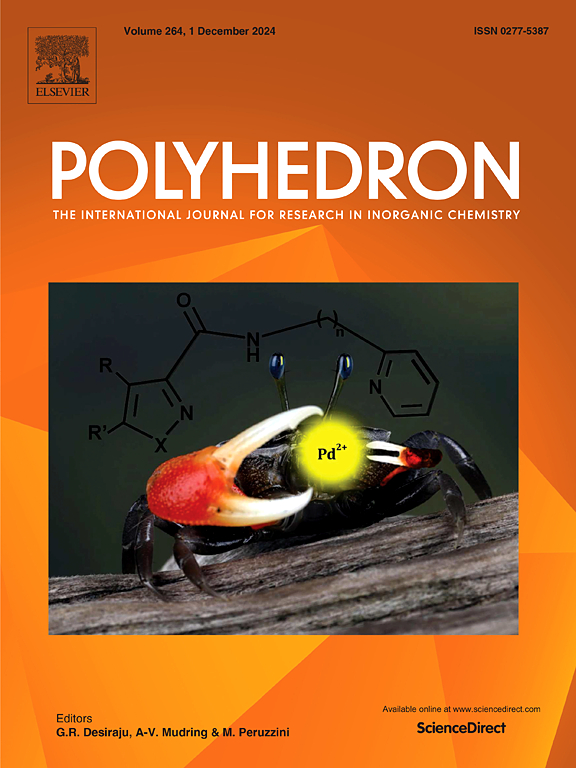从相变到光子学性能:用于下一代光电子学的InXAl1−XP (x = 0.0 0.25, 0.5, 0.75和1)三元合金的第一性原理探索
IF 2.4
3区 化学
Q2 CHEMISTRY, INORGANIC & NUCLEAR
引用次数: 0
摘要
采用基于全势线性化增广平面波(FP-LAPW)方法的密度泛函理论(DFT)在WIEN2k计算框架下系统地研究了AlP、InP及其混合合金InxAl1−xP合金(x = 0、0.25、0.5、0.75、1)的结构稳定性、压力诱导相变、弹性、光电和热性能。利用广义梯度近似(WC-GGA)的Wu-Cohen公式对交换相关相互作用进行处理,以评估其结构、弹性、光学和热性能。电子性质方面,采用PBE-GGA、WC-GGA和trans - blaha修正的Becke-Johnson (mBJ)势来提高能带结构计算的准确性。结构稳定性评估了几种晶体构型,包括闪锌矿、岩盐、氯化铯和纤锌矿相。研究结果表明,闪锌矿的结构在能量上是最稳定的。计算了相变压力,并与现有的理论和实验数据进行了比较,以验证结果。电子结构分析表明,这些合金具有宽带隙的半导体特性,使其适合光电应用。利用准调和德拜模型研究了热性能,从而全面了解了热容量、德拜温度和熵作为温度的函数。此外,还计算了弹性常数、弹性各向异性参数和详细的光学性质,从而全面了解了材料的特性。这些发现为InxAl1−xP合金的基础知识和潜在的技术应用做出了贡献。本文章由计算机程序翻译,如有差异,请以英文原文为准。

From phase transitions to photonics performance: First-principles exploration of InXAl1−XP (x = 0.0 0.25, 0.5, 0.75 and 1) ternary alloys for next-generation optoelectronics
Density Functional Theory (DFT) based on the full-potential linearized augmented plane wave (FP-LAPW) method has been employed to systematically investigate the structural stability, pressure-induced phase transitions, elastic, optoelectronic, and thermal properties of AlP, InP, and their mixed alloys InxAl1−xP alloys (x = 0, 0.25, 0.5,0.75,1) within the WIEN2k computational framework. The exchange–correlation interactions were treated using the Wu–Cohen formulation of the generalized gradient approximation (WC-GGA) to evaluate the structural, elastic, optical, and thermal properties. For electronic properties, the PBE-GGA, WC-GGA, and the modified Becke-Johnson (mBJ) potential by Tran-Blaha were employed to enhance the accuracy of the band structure calculations.Structural stability was assessed across several crystallographic configurations, including Zinc Blende, Rock Salt, Cesium Chloride, and Wurtzite phases. The findings indicate that the Zinc Blende structure is energetically the most stable among the studied phases. The phase transition pressures were calculated and compared with available theoretical and experimental data to validate the results.The electronic structure analysis reveals that these alloys exhibit semiconducting behavior with wide band gaps, making them suitable for optoelectronic applications. Thermal properties were investigated using the quasi-harmonic Debye model, yielding comprehensive insights into the heat capacity, Debye temperature, and entropy as functions of temperature. Furthermore, the elastic constants, elastic anisotropy parameters, and detailed optical properties were computed, providing a thorough understanding of the material characteristics. These findings contribute to the fundamental knowledge and potential technological applications of InxAl1−xP alloys.
求助全文
通过发布文献求助,成功后即可免费获取论文全文。
去求助
来源期刊

Polyhedron
化学-晶体学
CiteScore
4.90
自引率
7.70%
发文量
515
审稿时长
2 months
期刊介绍:
Polyhedron publishes original, fundamental, experimental and theoretical work of the highest quality in all the major areas of inorganic chemistry. This includes synthetic chemistry, coordination chemistry, organometallic chemistry, bioinorganic chemistry, and solid-state and materials chemistry.
Papers should be significant pieces of work, and all new compounds must be appropriately characterized. The inclusion of single-crystal X-ray structural data is strongly encouraged, but papers reporting only the X-ray structure determination of a single compound will usually not be considered. Papers on solid-state or materials chemistry will be expected to have a significant molecular chemistry component (such as the synthesis and characterization of the molecular precursors and/or a systematic study of the use of different precursors or reaction conditions) or demonstrate a cutting-edge application (for example inorganic materials for energy applications). Papers dealing only with stability constants are not considered.
 求助内容:
求助内容: 应助结果提醒方式:
应助结果提醒方式:


